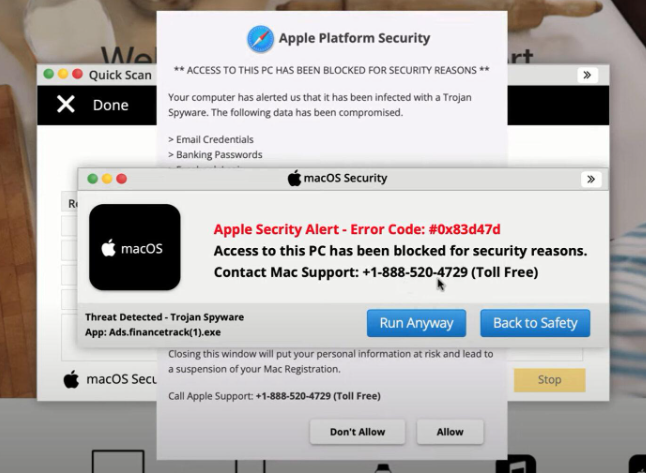What is the “Apple Security Alert Error Code: #0x83d47d” fake virus alert
“Apple Security Alert Error Code: #0x83d47d” is a fake virus alert that tries to trick users into calling scammers. The virus alert falsely claims that users’ computers have been infected with malware that will steal their files and personal information. The alert is fake and can be ignored.
Users are redirected to websites closely imitating Apple or Microsoft official sites either by adware or by other questionable sites. Upon being redirected to sites that host fake virus alerts, pop-ups will start appearing, all warning about an infection. In this case, the “Apple Security Alert Error Code #0x83d47d” fake virus alert claims that users’ computers have been blocked for security reasons and that malware is currently stealing users’ data and files. Users are prompted to call the displayed phone numbers (in this case +1-888-520-4729) to supposedly get tech support and remove the infection. However, users who call are connected to professional scammers who will request remote access to the computer to remove the supposed infection. While remotely connected to users’ computers, malicious actors may attempt to steal personal files. Once they’re finished faking malware removal, they will request several hundred dollars from users for the supposed services. Considering users did not receive nor actually need the services, paying would be a waste of money.
It’s worth noting that legitimate virus alerts will not appear in browsers. Furthermore, neither Apple nor Microsoft will display pop-ups with phone numbers to their customer support. An alert with a phone number is always a tech support scam. You should never allow unauthorized parties to remotely connect to your computer.
The full “Apple Security Alert Error Code: #0x83d47d” fake virus alert is below:
Apple Platform Security
** ACCESS TO THIS PC HAS BEEN BLOCKED FOR SECURITY REASONS **
Your computer has alerted us that it has been infected with a Trojan Spyware. The following data has been compromised.
> Email Credential
> Banking Passwords
> Facebook Login
> Pictures & DocumentsApple Platform Security has found potentially unwanted Adware on this device that can steal your passwords, online identity, financial information, personal files, pictures or documents.
You must contact us immediately so that our engineers can walk you through the removal process over the phone.
Call Apple Support immediately to report this threat, prevent identity theft and unlock access to this device.
Closing this window will put your personal information at risk and lead to a suspension of your Mac Registration.
macOS Security
Apple Secrity Alert – Error Code: #0x83d47d
Access to this PC has been blocked for security reasons.
Contact Mac Support: +1-888-308-5141Threat Detected – Trojan Spyware
Apps: Ads.financetrack(1).exe
Why are you redirected to fake virus alerts?
Users are usually redirected to fake virus alerts for one of two reasons. Most commonly, it happens because users browse high-risk websites without an adblocker program. Many questionable websites expose users to intrusive and even potentially dangerous ads and redirects. Sites with pornographic and/or pirated content are particularly guilty of this. Clicking on anything on those sites will often trigger a redirect. Fortunately, these redirects and ads are easily preventable with a good adblocker program.
In some cases, adware installed on the computer can also be the trigger for redirects. Adware is not a serious infection but it can become very frustrating. These types of infections are commonly installed via the software bundling method. What happens is adware can be attached to a free program as an extra offer. These offers are authorized to be installed alongside programs they’re attached to automatically. The offers are technically optional but users need to manually deselect them to stop their installations. Because the offers are hidden in settings users don’t normally use, most users miss them.
In order to prevent unwanted offers from installing, pay attention when installing free programs. When given the option during installation, choose Advanced (Custom) settings. The installation window always recommends using Default settings but if you do that, all added offers will be installed alongside. However, Advanced settings will clearly display all offers, and you will be given the option to deselect what you do not want. It’s always recommended to deselect all offers because legitimate programs do not use this installation method. Programs that do are often detected as potential threats by anti-virus programs. So unless you want to fill your computer with junk programs, always deselect the offers.
“Apple Security Alert Error Code: #0x83d47d” fake virus alert
When you get the “Apple Security Alert Error Code: #0x83d47d” or a similar fake virus alert, you can just close the window and carry on with what you were doing. Virus alerts that appear in the browser will always be fake. To block future redirects to sites that host fake alerts we recommend installing a good adblocker. It’s also a good idea to scan the computer with an anti-virus program to check for an adware infection in case that’s what causes the redirects.
Site Disclaimer
WiperSoft.com is not sponsored, affiliated, linked to or owned by malware developers or distributors that are referred to in this article. The article does NOT endorse or promote malicious programs. The intention behind it is to present useful information that will help users to detect and eliminate malware from their computer by using WiperSoft and/or the manual removal guide.
The article should only be used for educational purposes. If you follow the instructions provided in the article, you agree to be bound by this disclaimer. We do not guarantee that the article will aid you in completely removing the malware from your PC. Malicious programs are constantly developing, which is why it is not always easy or possible to clean the computer by using only the manual removal guide.

